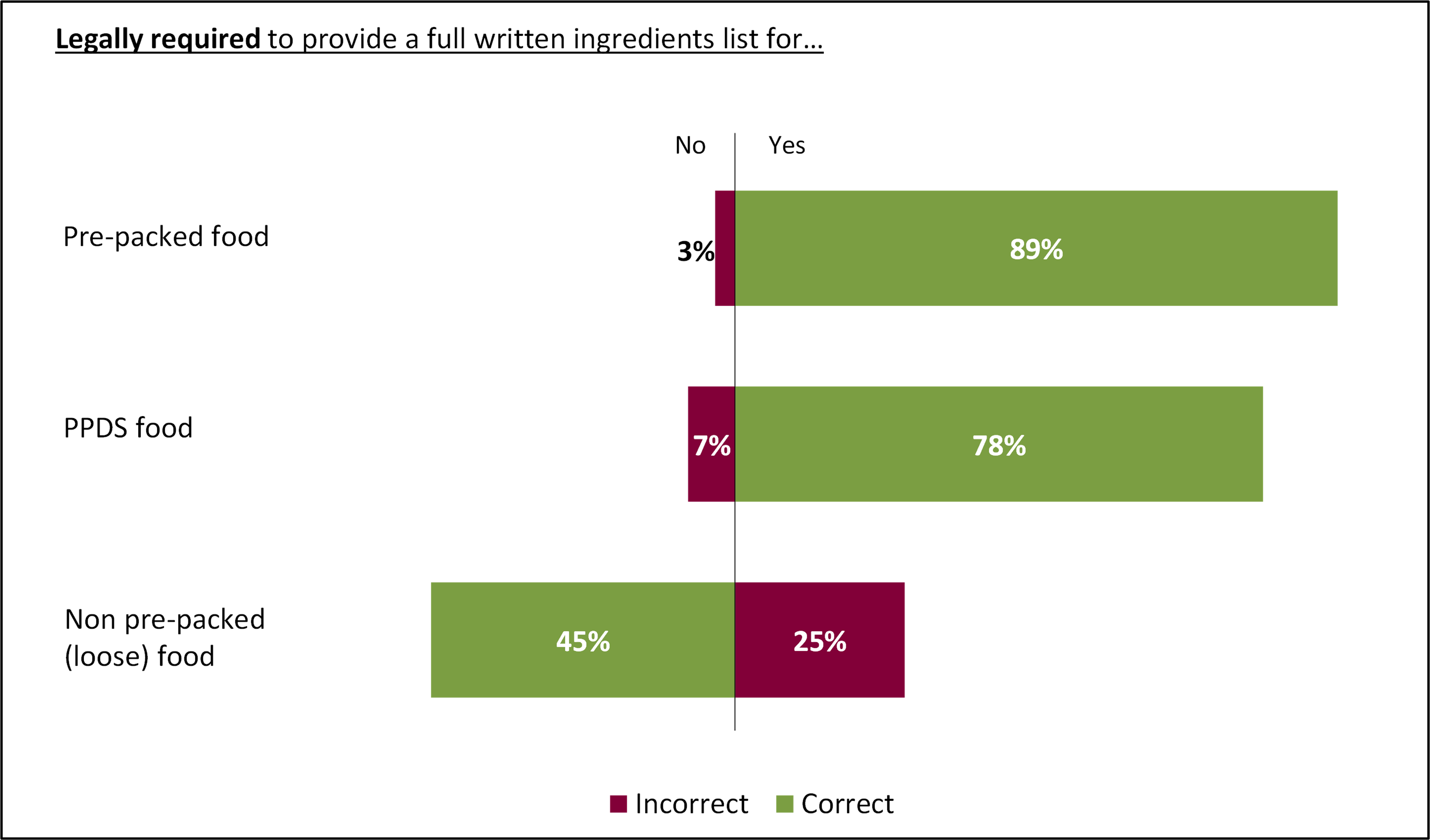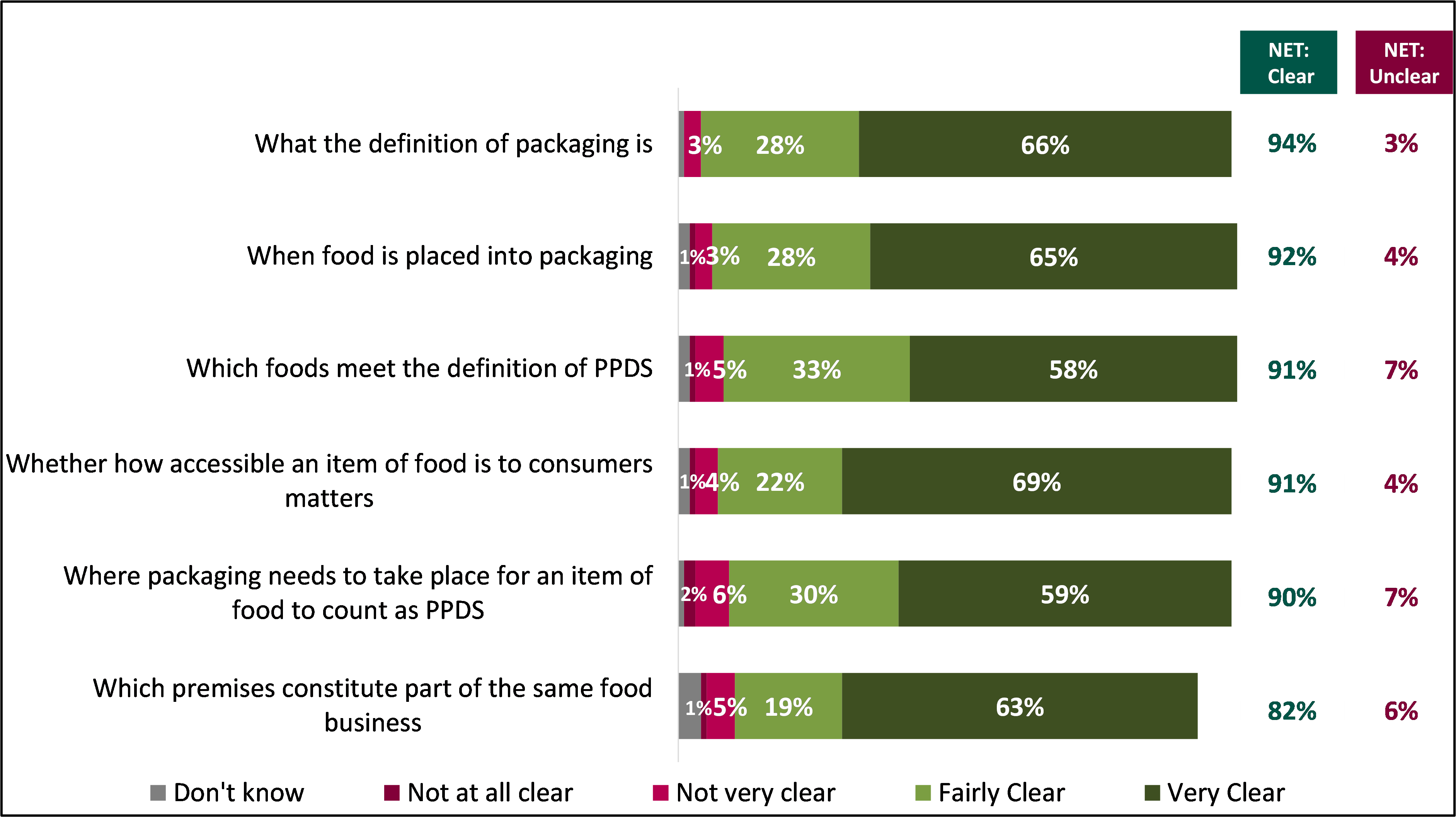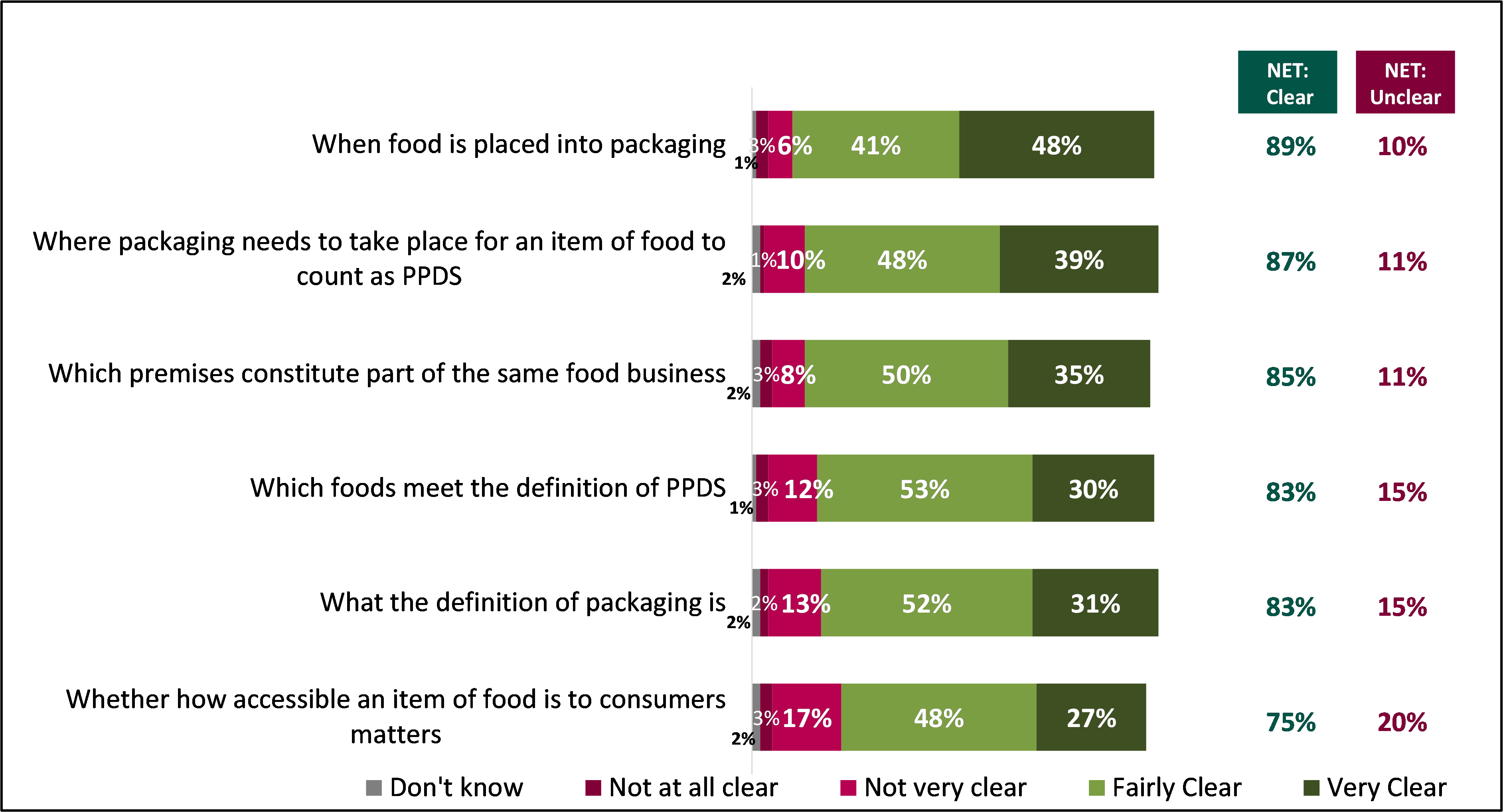Awareness and understanding of PPDS labelling requirements - PPDS evaluation
This chapter covers the awareness and understanding of Prepacked for Direct Sale (PPDS) foods and the associated labelling requirements amongst consumers with Food Hypersensitivities (FHS), Food Business Operators (FBOs) and Local Authorities (LAs).
Consumers
Awareness and understanding of PPDS foods
Around a quarter (26%) of consumers were aware of the term PPDS before they took part in the survey. There were no statistically significant differences by country in the proportion aware (England: 26%; Northern Ireland: 29%; Wales: 30%). However, there were differences by age and the nature of food hypersensitivity.
Awareness levels were generally higher among younger consumers: those aged between 18 and 34 were more likely than those aged 65 or older to be aware of the term PPDS (35% vs 17%). With regards to food hypersensitivities, those with an allergy other than Coeliac disease were more likely to be aware of the term PPDS, prior to taking part in the survey, than those with Coeliac disease (31% vs 22%). Those who reported both themselves and their child having a food hypersensitivity and those reporting just their child having a food hypersensitivity were both more likely to have heard of the term before compared with those reporting just themselves with a food hypersensitivity (38% and 32% respectively vs 23%).
Interviews with consumers highlighted that they typically became aware of the term PPDS through a food hypersensitivity charity or from media coverage of Natasha Ednan-Laperouse’s death. Some stated they became aware after they or someone close to them was diagnosed with a food hypersensitivity.
“I followed Natasha's Law. Her parents have an Instagram page that they run and I follow that and it was on there [the term PPDS].”
Consumer, Northern Ireland, Severe hypersensitivity
"[I became aware of PPDS] Quite quickly after [my child] was diagnosed [with coeliac disease] a year ago."
Consumer, Wales, Severe hypersensitivity
After the survey captured awareness levels, the term was defined and explained to consumers as follows: 'Pre-packed for direct sale (PPDS) foods are packed on the same premises as they are being sold to consumers and where the food is packed before being offered for sale to customers’. Following this, consumers were asked to what extent it would be easy or difficult to identify such food. As shown in Figure 4.1, around half (52%) of consumers said that it would be difficult for them to identify if food was packaged on site and therefore whether it would classify as PPDS (with 22% reporting that it would be very difficult).
Figure 4.1 Extent to which consumers found identifying whether food was packaged on site easy or difficult

C2. If you entered a food business, how easy or difficult would it be to identify whether food was packaged on site? Base: All consumers (1809)
There were again no statistically significant differences by country in the proportion who found it difficult to identify whether food was packaged on site (England: 53%; Northern Ireland: 50%; Wales: 51%). However, those in Northern Ireland were more likely to find it easy than average (26% vs 19% overall).
The likelihood of reporting difficulty with identifying PPDS foods increased with age and food hypersensitivity severity. Those aged 18 to 34 perceived it to be easier than both those aged 35 to 64 and those aged 65 or older (32% vs 19% and 10% respectively).Those with a mild allergy or intolerance were more likely than those with either a moderate and severe allergy to find it easy (31% vs 21% and 16% respectively), while those with a moderate or severe allergy or intolerance were more likely to find it difficult (49% and 57% vs 52%). Those also reporting both themselves and their child having a food hypersensitivity were more likely than those reporting just themselves or just their child having a food hypersensitivity to perceive it to be easier (28% vs 17% and 19% respectively).
During qualitative interviews, some said it would be difficult for them to identify if food was packaged on site, because PPDS foods were often placed alongside other prepacked food. Others said it could be harder to determine when printed labels and branded packaging is used, cited as more common in larger outlets, as this packaging can mirror the appearance of non PPDS foods.
“[Supermarkets] have cold meat in the deli in packaging, and I am unsure whether they package it centrally or in-store.”
Consumer, Wales, Moderate hypersensitivity
“In larger stores [identifying PPDS] it is quite difficult; in local outlets it would be quite easy.”
Consumer, England, Severe hypersensitivity
Awareness and understanding of PPDS labelling requirements
The PPDS labelling requirements were defined and explained within the survey ahead of questions around awareness of them. Once defined, the vast majority (87%) reported having heard of PPDS labelling requirements, although only a small proportion (18%) knew a lot about it, as shown in Figure 4.2.
Figure 4.2 Consumer awareness of new PPDS labelling requirements

D1. Before today, to what extent were you aware of the new PPDS food labelling requirements, or Natasha’s Law? Base: All consumers (1809)
Awareness of PPDS labelling requirements was broadly similar across the three countries (England: 88%; Northern Ireland: 84%; Wales: 88%). However, those with Coeliac disease were more likely than those with another food hypersensitivity (91% vs 83%) and those with an allergy to a regulated allergen were more likely those with only an allergy to a non-regulated allergen (89% vs 76%) to have heard of the new requirements, regardless of understanding.
Parents who reported having a child with a food hypersensitivity and those reporting both themselves and their child having a food hypersensitivity were both more likely than those reporting just themselves having a food hypersensitivity to have heard of the new labelling requirements and knowing quite a lot about it (23% and 25% respectively vs 15%). Similarly, those with a severe allergy were more likely to report having heard of the new labelling requirements and knowing quite a lot about it than those with a mild or moderate allergy (21% vs 10% and 15% respectively).
Consumers typically first heard of the new PPDS labelling requirements from traditional media sources. As shown in Figure 4.3, half (50%) of consumers became aware via local or national newspapers or TV, followed by 30% who learned of the requirements from a registered charity, and 19% via social media.
Figure 4.3 How consumers became aware of the new labelling requirements

D2. How did you hear about the new PPDS food labelling requirements? Base: All consumers who were aware of the new labelling requirements (1582).
Across the three countries, traditional media, local or national newspaper or TV, was the top source of awareness (England: 51%; Northern Ireland: 42%; Wales: 37%). In England this was followed by registered charities (30%) and in Northern Ireland and Wales social media (41% and 30% respectively).
There were some differences by age with those aged 65 or older were more likely to have become aware of the new labelling requirements through local or national newspaper or TV than those aged 18 to 34 and those aged 35 to 64 (60% vs 34% and 49% respectively). Additionally, those aged 18 to 34 and those aged 35 to 64 were both more likely to have become aware through social media or the FSA’s website than both those aged 65 or older (social media: 33% and 21% vs 8%; FSA website: 17% and 9% vs 5%).
In addition to being asked about their awareness of PPDS labelling requirements, consumers were also asked which types of food they thought FBOs were legally required to provide written full ingredient lists for. The majority correctly identified that there is a legal requirement for written full ingredients lists to be provided on prepacked food (89%) and PPDS foods (78%) as shown in Figure 4.4. However a quarter (25%) incorrectly thought this was also a legal requirement for non-prepacked food, with less than half (45%) correctly identifying it was not.
Figure 4.4 Awareness of FBOs legal requirements for providing food information

B4. As far as you are aware, which of the following types of food are businesses legally required to provide written full ingredient lists for? Base: All consumers (1809).
Across these three food types, a third (32%) of consumers were aware of the legal requirements for providing food information for all three categories (prepacked food, PPDS food and non-prepacked (loose) food), 52% for any two categories, and only 5% were unaware for all 3 foods. Consumers in Northern Ireland and those aged 18 to 34 were both more likely than average to have selected all three statements correctly (44% and 39% vs 32%).
Consumers shared whether, in their view, PPDS foods only needed to be labelled with information about whether they contain any of the 14 specified allergens, rather than with a full ingredients list. As illustrated in Figure 4.5, two-thirds (67%) disagreed with this, in line with new PPDS requirements, and only around a fifth agreed (21%).
Figure 4.5 Consumers view on if PPDS only needed labelling if they contain an allergen

C8. 'In my view, foods prepacked for direct sale (PPDS) only need to be labelled with information about whether they contain any of the 14 specified allergens, rather than with a full ingredients list' Base: All consumers (1809).
By age, those aged between 35 to 64 were more likely to disagree than those aged 65 or older (69% vs 58%). Those with a regulated allergen were more likely than those with only a non-regulated allergen and those with both a regulated and non-regulated allergen to agree that PPDS foods only needed labelling if they contain any of the 14 specified allergens (22% vs 15% and 17%).
During qualitative interviews, many were aware of the new labelling requirements, their purpose, and its aim being to better protect and inform those with a food hypersensitivity when purchasing PPDS foods. Despite this, many struggled to define specifically what was required under the new labelling requirements.
This high-level awareness allowed many to provide a broad definition and those who had noticed changes in PPDS foods labelling were able to presume what the new legislation required from these changes.
"They've [FBOs] probably got legal requirements although I'm not quite sure what they are. You just assume and hope that companies are doing the legal requirement.”
Consumer, England, Severe hypersensitivity
“I've noticed the changes because packaging is very clear now, it's obvious you don't have to think, ‘Does it contain [allergens]?’ If you weren't sure, it is there written on the packaging for you.”
Consumer, England, Moderate hypersensitivity
Many agreed with the new legislation and believed all PPDS foods should have labels. There was also surprise amongst some that this has not always been a requirement for FBOs on PPDS foods.
"As there are less common allergies, it is important to have all ingredients on the packaging."
Consumer, England, Severe hypersensitivity
“I know they were trying to push for a law but the scary thing is that law only came into place because somebody died.”
Consumer, England, Severe hypersensitivity
Food Business Operators
Awareness and understanding of PPDS foods
Two-thirds (66%) of FBOs reported being aware of the term PPDS before participating in this research; with around a third (33%) having not heard of the term.
There were no statistically significant differences by country in terms of awareness of the term PPDS (England: 66%; Northern Ireland: 65%; Scotland: 69%; Wales: 63%). However, amongst those who currently sell PPDS foods there were differences by sector. Both butchers and delicatessens were more likely to be aware of the term PPDS, prior to this survey (79% and 80% vs 66% overall).
After the survey captured awareness levels of the term PPDS, the term was defined and explained to FBOs as: Pre-packed for direct sale (PPDS) foods that is packed before being offered for sale by the same food business to the final consumer, where this takes place on the same premises or location; or from moveable or temporary premises such as a market stall or mobile sales vehicle, before asking to what extent six particular aspects of the PPDS definition were clear to them. As shown in Figure 4.6, FBOs reported that they felt the PPDS definition – across all aspects – was clear, with four fifths clear about each aspect (80%), ranging from 94% of FBOs who felt the definition of packaging was clear, to 82% of FBOs who felt it was clear which of their premises constitute part of the same food business. However, a fifth (20%) were unclear on at least one aspect.
Figure 4.6 FBOs: aspects of the PPDS definition considered clear

A4. To what extent, if at all, are the following aspects of the definition of PPDS clear to you? Base: All FBOs (900). *NB FBO’s were only asked this statement if they had multi-site establishments (394).
Amongst those who sold PPDS foods at the time of the survey, butchers and general retail were more likely than average to be clear on all aspects of the definition (88% and 86% respectively). (footnote 1) In contrast, catering venues who sold PPDS foods were less likely to be clear on all aspects of the definition than those who sell PPDS foods (72%).
Awareness also varied by size; FBOs with 11 or more employees who sold PPDS were more likely to say they were clear on all aspects of the definition (88%) than smaller FBOs with between 1 and 5 employees (76%) and or between 6 and 10 employees (82%).
Reflecting the results of the survey, during qualitative interviews most FBOs said they had a good understanding of what constitutes PPDS food. However, some explained that they initially faced a steep learning curve as it was not a term that they had used internally prior to the PPDS labelling requirements being announced.
“I initially thought they're not pre-packaged. You have to look at it from the customer not from you as the supplier. From a customer's perspective yes, it's a PPDS product.”
FBO, England, Catering, 11 or more employees
Some FBOs explained that they occasionally encountered confusion about the definition of PPDS. For example, the owner of a mobile food business said that they were unclear whether pre-ordered meals for collection counted as PPDS while a butcher was uncertain whether products packaged at an offsite kitchen met the definition of PPDS.
“The confusing thing for us is sometimes there will be people that ring up and say, ‘right we want four vegetarian meals and four meat dinners, we’re coming at four to pick it up’. We feel like we're in a bit of a limbo with that.”
FBO, England, Catering, 11 or more employees
“Butchery products are prepared onsite but everything else is prepared offsite and I’m not sure if they actually count as PPDS.”
FBO, England, Delicatessen, 11 or more employees
Awareness and understanding of PPDS labelling requirements
Most FBOs (91%) were aware of the PPDS labelling requirements before taking part in the research, with few (8%) reporting they were unaware.
There were no statistically significant differences by country in terms of awareness of the PPDS labelling requirements before taking part in the research (England: 90%; Northern Ireland: 94%; Scotland: 91%; Wales: 88%).
Amongst those who sold PPDS foods currently there were differences in awareness by sector and size. Catering and general retail FBOs were more likely than average to report being aware of the legal requirements to label PPDS foods (96% and 95% respectively). Conversely restaurants and cafes were less likely than average to state they were aware (83% vs 91%). With regards to size, FBOs with 11 or more employees, who currently sold PPDS, were almost wholly aware of the labelling requirements and as a result more likely be aware than average (97% vs 91%). Those with between 1 and 5 employees and those with between 6 and 10 employees were less aware than those with 11 or more employees (87% and 90% vs 97%).
During qualitative interviews, most FBOs demonstrated good awareness and understanding of PPDS labelling requirements. As with the definition of PPDS, many had experienced points of uncertainty and confusion to begin with, but these generally passed following the receipt of guidance or training. A few reported changing their practices around where confusion persisted.; for example, selling foods that were formally PPDS as loose foods. Further detail on such changes to practices is presented in Chapter 6.
“The biggest challenge was simply figuring out what had to go on the labels … It took a while to sort out, but it’s fine now.”
FBO, Scotland, Restaurant/café, 1 to 5 employees
“There was a grey area where we had sandwiches we had prepared, and we would wrap them in a wax wrap just to keep the sandwich together. Our consultant said that was too on the line, so we now sell it loose without any packaging to skirt around that.”
FBO, England, Retail, 11 or more employees
Most LAs that took part in qualitative interviews believed FBOs generally had good awareness and understanding of PPDS labelling requirements. However, some identified small independent FBOs and takeaways as an exception to this. These FBOs were said to have lower awareness and understanding of PPDS labelling requirements owing to them not having the time or dedicated staff to engage with food information regulations and, where English is not the first language of owners and staff, because guidance was difficult to understand.
“You might have a one-man band that doesn’t have the technical expertise or resource to help with it and he will probably do nothing until we come along and give advice.”
Local Authority, Scotland
“Sometimes, with a language barrier, explaining the PPDS labelling requirements can be even more difficult. They don’t understand it.”
Local Authority, England
Local Authorities
Awareness and understanding of PPDS foods
Close to three-fifths (57%) of LAs reported being clear on all aspects of the definition of PPDS presented to them. The lowest level of understanding was whether the accessibility of the food (to consumers) matters (75% said this was clear to them), as shown in Figure 4.7. This was followed by: what the definition of packaging is (83%); and which foods met the definition of PPDS (83%).
Figure 4.7 LAs: Aspects of the PPDS definition considered clear

B2. To what extent, if at all, are the following aspects of the definition of PPDS clear to you? Base: All LAs (126).
In the qualitative interviews, many LAs reported receiving guidance from the FSA or FSS but felt that this guidance was not always clear on which foods meet the definition of PPDS, mostly around the definition of prepacked in relation to direct sale. Specifically, some LAs were unclear on the impact accessibility of food and when packaging takes place has on the requirements.
One example an LA gave of this confusion was between two examples provided by the FSA, specifically scenarios 4 and 5b. (footnote 2) They felt the guidance left this scenario unclear: If an FBO made sandwiches in bulk, wrapped these individually in cling film, then placed them in a fridge, away from consumers reach or sight. A consumer then later orders the item, staff retrieve the sandwich remove all the cling film and place the sandwich into a takeaway container before presenting it to the consumer. The LA thought, against their initial interpretation, using both examples that this would not be PPDS and not require labelling.
“Before the second set of [FSA] guidance came out I thought I was fairly clear on what was prepacked for direct sale and what wasn't. The second set of guidance I thought over complicated things. They gave a lot of examples and some of them are contradictory.”
Local Authority, Wales
“There is guidance on the FSS website and a flow diagram which answers questions. I think it would help to know where all the LAs are in relation to these issues. FSS were looking for us to report to them with any anomalies we had identified, should a prawn cracker be on a report and should we be enforcing it.”
Local Authority, Scotland
“Our frustrations are born out of the guidance itself, which has made it far more complicated and onerous than it needed to be.”
Local Authority, England
Awareness and understanding of PPDS labelling requirements
LAs understanding of the labelling requirements was generally high across the qualitative interviews. Most were aware that the PPDS labelling requirements consisted primarily of making ingredients of foods that are readily available to consumers more accessible and visible; and were able to translate what this meant in practice for FBOs and in terms of compliance checks.
“Once [FBOs] are aware of what needs to be on it, they get it right even if it takes a few goes.”
Local Authority, Scotland
Most LAs explained that they had developed their understanding of PPDS and the associated labelling requirements primarily from guidance produced by the FSA and FSS. Many felt that this guidance had provided them with clarity.
“Knowledge hub, specific for standards officers, is a very useful source.”
Local Authority, England
“The [FSS] were proactive and sent out a letter to Local Authorities and enforcement letters and gave us quite a bit of resource to pass on which is still on the website.”
Local Authority, Scotland
Where instances of confusion were found, it was typically amongst specific foods or areas of the legislation rather than general understanding. Many LAs were aware of the purpose and need behind the requirements, and were supportive of them, but felt finer details were absent or not clear to them.
"Some of it is obvious but some things there is no concrete guidance on - we've had bakers where some bread is enclosed in a package, some not. Some bakeries selling pieces of cake, and the last piece is wrapped in clingfilm, should that fall within it?"
Local Authority, England
Confusion also extended to some specific foods at takeaway premises that are made in bulk, then prepacked ahead of an order and bundled later with an order of non-prepacked food. Some felt these items should not be classed as PPDS and not require full labelling as they form part of an order on non-prepacked food.
“Takeaways with prawn crackers in bags, tartar sauce for fish and chips [are all covered]. It should be more directed to grab and go, grab a sandwich and you are away. I don’t think things behind the counter or in a kitchen should be included. Some Local Authorities with fast food and takeaways are saying just label everything.”
Local Authority, Scotland
Some LAs felt they had a very clear understanding of the new PPDS labelling requirements and spoke about the resources they used to assist colleagues involved in compliance checks. An example of third-party resources used can be seen in the case study presented in Figure 4.8, which covers the experience of an English LA and an FBO under their jurisdiction.
Figure 4.8 Case study: awareness and understanding (accessible version)
A Local Authority in England that reported feeling “totally clear” on the definition of PPDS foods and the labelling requirements.
The Local Authority was aware of resources being available from the FSA to assist Local Authorities but had not engaged with them. Instead the Local Authority had used guidance available on the BusinessCompanion website. This guidance was printed off and shared with all employees involved in compliance checks.
“I think much more can be done to encourage both businesses and Environmental Health Officers to be aware of Business Companion because it is a really good resource.”
It was felt that most businesses within the Local Authority’s jurisdiction were aware of the PPDS labelling requirements, but understanding was variable. Smaller independent businesses were highlighted as the most likely to have issues with understanding. This was attributed to a range of factors, namely: time and resources constraints, shifting supply chains and language barriers. By contrast, it was commented that larger businesses that formed part of a chain typically has an in-depth understanding of PPDS labelling requirements.
“[Small businesses] have so many other things to do that they don't have time. I think these businesses have also been clobbered quite hard by COVID, so I think the timing of the legislation has been an issue too.”
A petrol station, located in the same Local Authority, with more than 11 employees. The manager and staff of this FBO had a good understanding of PPDS labelling requirements following the delivery of regular training and written guidance delivered by the business’s head office.
“Everybody in the business had to re-do their allergen training, and it was updated with the most recent legislation. It was made clear to me as a manager as well as my team members why those changes were coming and the part we needed to play.”
The manager had not engaged with any support and guidance available from their Local Authority. They had not felt a requirement to do so as they feel well equipped from the support provided by their head office.
The FBO had received visits from Environmental Health Officers since October 2021, but these visits had not involved guidance on PPDS labelling requirements. The manager assumed this is because the site is operating compliantly.
-
92% of all FBOs sold PPDS foods at the time of the survey (n=828).
-
FSA LA Guidance: Annex B - Examples of prepacked for direct sale food.